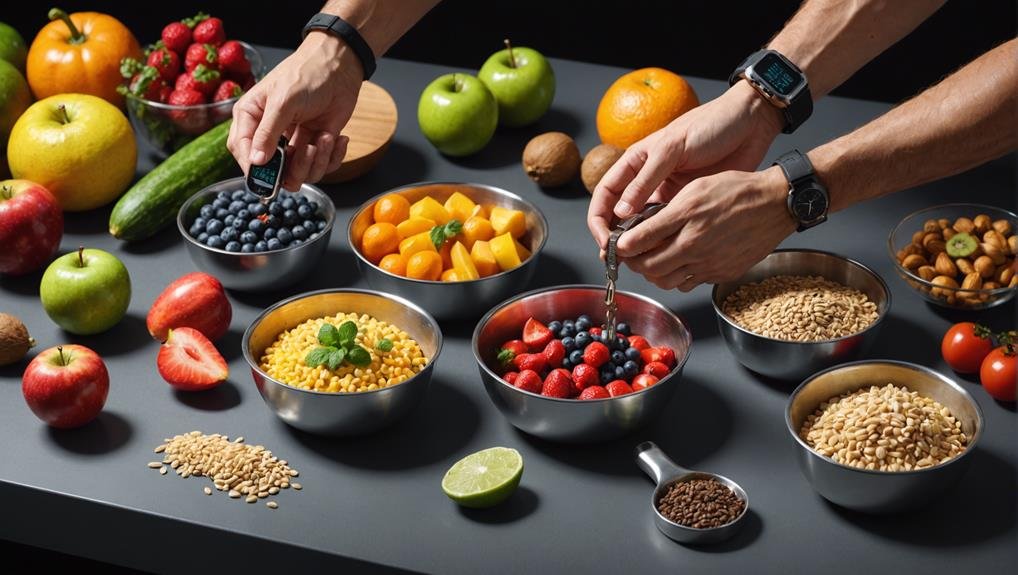Mastering Calorie Control: A Simple Guide
Mastering calorie control is essential for reaching your health goals. Understand that calories are energy units from food, with fats being more calorie-dense than carbs or proteins. Watch out for hidden calories in high-fat and sugary foods. Focus on portion sizes and choose nutrient-rich options. Tracking your intake and setting realistic goals is key. Beware of myths like fat-free foods often contain added sugars. Implement portion control and mindful eating habits. Making small changes can lead to significant results. Stay committed to mastering calorie control for long-term success in your health journey.
Key Takeaways
- Understand calorie sources from different foods
- Practice portion control for mindful eating
- Track caloric intake for better awareness
- Opt for nutrient-dense food choices
- Implement small changes for significant results
Understanding Calorie Basics
Understanding calorie basics involves grasping the concept of how calories are units of energy that come from the foods and beverages you consume. Important in meal planning as different foods provide varying amounts of energy.
Calorie counting techniques help you monitor your intake, but there are misconceptions to be aware of, such as the fact that fat contains more calories per gram than carbs or proteins. Cutting fat doesn't always equate to cutting calories, as some fat-free foods may have added sugars, increasing their caloric content.
When planning your meals, consider the overall caloric impact of your food choices to maintain a balanced diet. Being mindful of these factors will support your journey towards better health and well-being.
Identifying Calorie Sources
Identifying the primary sources of calories in your diet is essential for maintaining a balanced and healthy eating pattern. Calorie dense foods are often high in fats and sugars, packing a significant amount of energy in small portions.
Be cautious of hidden calories found in seemingly healthy choices like salad dressings, granola bars, or flavored yogurts, which can add up quickly. Pay attention to portion sizes and be aware that some low-fat products may have added sugars to improve taste, increasing calorie content.
Reading labels and understanding ingredients can help you identify where the majority of your daily calories are coming from, allowing you to make informed decisions about your diet.
Managing Caloric Intake
To effectively manage your caloric intake, focus on portion control and mindful food choices. It's crucial to track progress and set goals to guarantee you stay on the right path. Making small changes like measuring portions and choosing nutrient-dense foods can have a significant impact. Here is a table to help you visualize how you can manage your caloric intake effectively:
| Caloric Intake Management Tips | Description |
|---|---|
| Track Progress | Monitor food intake and adjust as needed |
| Set Goals | Establish realistic calorie targets |
| Portion Control | Use measuring tools for accurate servings |
| Mindful Food Choices | Opt for nutrient-rich options |
Exploring Calorie Myths
Managing your caloric intake effectively involves debunking common misconceptions surrounding calories. Fat, often seen as the main culprit, contains more calories per gram than carbs or proteins, but cutting fat doesn't always equate to cutting calories.
Surprisingly, some fat-free products may have higher calorie content due to added sugars. It's important to recognize that low-fat doesn't necessarily mean low-calorie, especially when consumed in large amounts.
Being mindful of where your calories come from in your diet is essential. By exploring the facts and fiction about calorie sources, you can make more informed choices to support your overall health and weight management goals.
Stay informed to navigate the sea of calorie myths for a successful calorie control journey.
Implementing Calorie Strategies
Wondering how to effectively implement calorie strategies for best health and weight management?
Start by embracing calorie tracking to understand your intake better. Utilize apps or journals to monitor what you eat.
Practice portion control by using smaller plates, measuring servings, and being mindful of portion sizes. This simple technique can make a significant impact on your calorie consumption.
By tracking and controlling your portions, you can better manage your overall calorie intake. Remember, small changes in portion sizes can lead to big results when it comes to calorie control.
Stay committed to these strategies for long-term success in achieving your health and weight goals. Mastering calorie control is within your reach through mindful calorie tracking and portion control.
Enhancing Calorie Awareness
Start by increasing your awareness of calorie content in foods to make more informed and balanced dietary choices. Utilize calorie tracking tools to monitor your intake and gain insight into where your calories are coming from. Practice mindful eating by paying attention to portion sizes and savoring each bite.
Incorporate daily meal planning to guarantee you meet your calorie goals while enjoying a variety of nutritious foods. Make healthy swaps like choosing fruits and vegetables over high-calorie snacks to help manage your overall calorie intake.
Being conscious of calorie content in foods can guide you towards a more balanced diet and support your weight management efforts. Stay mindful of your choices and aim for a well-rounded approach to calorie awareness.
Practicing Calorie Control
To effectively control your calorie intake, focus on making mindful food choices and monitoring your portion sizes consistently. Start by implementing calorie tracking tips to understand your daily intake better.
Keep a food journal or use a calorie tracking app to stay on top of your consumption. Practice portion control tricks like using smaller plates, measuring servings, and avoiding second helpings.
Opt for mindful eating and make calorie-conscious choices by selecting nutrient-dense foods that are lower in calories but high in essential nutrients. Be aware of hidden calories in sauces, dressings, and beverages.
Balancing Calories and Activity
Achieve peak health by maintaining a balance between your calorie intake and physical activity levels. Activity tracking is essential to understand how many calories you burn throughout the day.
By monitoring your activity levels, you can adjust your calorie intake accordingly to make sure you're meeting your body's needs. Keep in mind that different activities burn varying amounts of calories, so tailoring your diet to your physical exertion is vital.
Aim to strike a balance between the calories you consume and those you expend through activity. This equilibrium is key to managing your weight effectively and promoting overall well-being.
Navigating Calorie Alternatives
Monitoring your food choices and portion sizes can offer effective alternatives to traditional calorie counting methods. Portion control plays an important role in managing calorie intake. Opt for healthy choices by selecting nutrient-dense foods that are lower in calories but high in essential nutrients.
Fill your plate with colorful vegetables, lean proteins, and whole grains to maintain a balanced diet while keeping calories in check. Be mindful of portion sizes to prevent overeating, as even healthy foods can contribute to excess calorie consumption when consumed in large amounts.
Achieving Calorie Mastery
By understanding the principles of calorie control and mastering the art of mindful eating, you can effectively manage your daily energy intake for peak health and weight management. When it comes to achieving calorie mastery, two key strategies are calorie tracking and portion control. Calorie tracking involves monitoring the number of calories you consume each day, while portion control focuses on managing the size of your food servings. Implementing these techniques can help you stay within your calorie goals and make informed choices about what you eat. Below is a table illustrating how calorie tracking and portion control work hand in hand:
| Calorie Tracking | Portion Control |
|---|---|
| Monitor daily calorie intake | Manage food portion sizes |
| Use apps or journals for tracking | Use smaller plates and utensils |
| Read nutritional labels | Avoid oversized servings |
| Plan meals in advance | Listen to your body's hunger cues |
Conclusion
Congratulations on taking the first steps towards mastering calorie control! While it may seem overwhelming at first, remember that small changes can lead to big results.
One common objection is the belief that calorie counting is too time-consuming, but with practice, it can become second nature. By understanding calorie basics, identifying sources, and implementing strategies, you can achieve calorie mastery and improve your overall well-being.
Keep up the great work!







